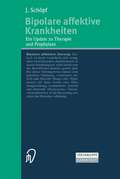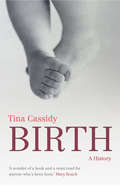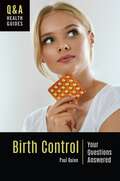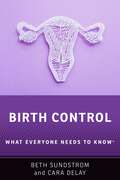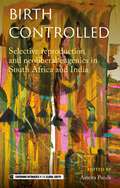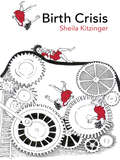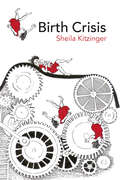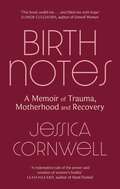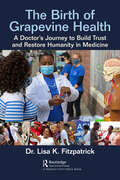- Table View
- List View
BipolART: Art and Bipolar Disorder: A Personal Perspective
by Denys N. WheatleyWritten with disarming honesty by a long-term sufferer of bipolar disorder, with more than half a century’s experience of intervention and treatment, this highly personal volume traces the effectiveness of a therapy modality for mental illness that has gained much ground in the past two decades: art. The author began to use art, and in particular doodling, from 1998 as a way of externalizing his feelings. Its expressiveness, accessibility and energy-efficiency was ideally suited to the catatonia he experienced during the bouts of depression that are a feature of bipolar disorder, while as the low moods lifted and his energy surged, he completed more ambitious and elaborate works. As well as being highly eclectic, Wheatley’s assembled oeuvre has afforded him both insights and therapeutic intervention into his condition, once deemed highly debilitating and taboo, but much more socially accepted now that well known sufferers such as Stephen Fry have recounted their experiences of the condition. After an opening account of how the images were generated, the volume reproduces a ‘gallery’ of selected work, and then offers an extended epilogue analyzing the art’s connections with the disorder as well as the author’s assessment of how each attempt at visual self-expression was, for him, a therapeutic intervention. Wheatley, a cell biologist who has enjoyed a full career in cancer research, has had no formal training in art, yet his haunting pictures, many of them resembling life forms, are brought to life by his perceptive, self-aware commentary. This book will be of interest to psychologists and psychiatrists among the wider medical profession as well as people suffering from any form of bipolar disorder whatever the severity.
Bird Keeping as a Source of Lung Cancer and Other Human Diseases: A Need for Higher Hygienic Standards (International Archives of Occupational and Environmental Health. Supplement)
by Peter A.J. HolstBirdkeeping is becoming increasingly popular, but could it threaten good health? This book discusses the evi- dence suggesting that keeping pet birds is a strong risk factor for lung cancer. Its relation to a number of other endpoints, including death before age 60 and spontaneous abortion, is also examined. In addition, the book looks at the diseases that can be transmitted from birds to man - a fairly unknown field in general medicine. For instance, birds are a source of airborne particles that can cause allergic reactions in humans. People who keep birds as pets tend to have a higher incidence of shortness of breath, colds, sore throats and other flu-like symptoms than those in households without birds. The evidence presented in this book is the result of a ten-year general practice survey. Some recommendations for future research are given.
Birds of Prey: Health and Disease
by John E. CooperRaptor biology has evolved enormously since the publication of the original edition of this book under the title Veterinary Aspects of Captive Birds of Prey. With the help of leading international experts, John E. Cooper has updated and expanded this classic reference to include all the latest data on the health and diseases of raptors. While still serving the needs of veterinary surgeons who treat birds of prey, Birds of Prey: Health & Disease also appeals to a wide readership of falconers, avian researchers, breeders, rehabilitators and zoo staff. Important changes to this new edition are the inclusion of data on free-living birds, additional material on fractures, pathology, legislation and poisons, and new sections on neonatology, health monitoring, captive-breeding and host-parasite relations. This book reviews all aspects of birds of prey, giving invaluable up-to-date information on diseases and pathology, but also looking at the history of the subject, the origins of terms, the evolution of current thinking and ending with a reliable list of primary references for further reading.
Birth: A History
by Tina CassidyThe engaging and eye-opening story of how we and our ancestors entered the world.Through the frigid, blurry January weeks after George was born, I found myself suddenly housebound with time to ruminate - though not time to cook or take a shower. When George was peaceful, my mind returned to that nagging question: why is birth so hit and miss after all this time? I needed to put into perspective my own experience. I needed to know what other women, in other cultures, in other times had done.Birth is a book that will open the eyes of even the most informed experts on the subject. Cassidy looks at every aspect of childbirth - from fathers and mothers to doctors and widwives across the centuries - with admirable objectivity in a work that is utterly gripping, occasionally shocking and essential reading for the human race.
Birth Control: Your Questions Answered (Q&A Health Guides)
by Paul QuinnThis book will serve as a scientifically accurate yet easy-to-read introduction to birth control for teens and young adults. The information, guidance, and resources it offers will help readers to make better decisions regarding their sexual health.From barrier methods such as condoms and diaphragms to oral contraceptive pills and from hormone-based implants and injectables to permanent sterilization techniques, there are a number of ways to prevent unwanted pregnancy today. But which are the most effective, and how do you choose the method that's right for you? What about side effects and long-term implications for health, such as increased risk for cancer? Does birth control affect your chances of getting pregnant in the future? Birth Control: Your Questions Answered, a part of Greenwood's Q&A Health Guides series, provides clear, concise answers to these and other questions young readers may have about this sometimes embarrassing, yet very important, topic. Each book in this series follows a reader-friendly question-and-answer format that anticipates readers' needs and concerns. Prevalent myths and misconceptions are identified and dispelled, and a collection of case studies illustrates key concepts and issues through relatable stories and insightful recommendations. The book also includes a section on health literacy, equipping teens and young adults with practical tools and strategies for finding, evaluating, and using credible sources of health information both on and off the internet—important skills that contribute to a lifetime of healthy decision-making.
Birth Control: Your Questions Answered (Q&A Health Guides)
by Paul QuinnThis book will serve as a scientifically accurate yet easy-to-read introduction to birth control for teens and young adults. The information, guidance, and resources it offers will help readers to make better decisions regarding their sexual health.From barrier methods such as condoms and diaphragms to oral contraceptive pills and from hormone-based implants and injectables to permanent sterilization techniques, there are a number of ways to prevent unwanted pregnancy today. But which are the most effective, and how do you choose the method that's right for you? What about side effects and long-term implications for health, such as increased risk for cancer? Does birth control affect your chances of getting pregnant in the future? Birth Control: Your Questions Answered, a part of Greenwood's Q&A Health Guides series, provides clear, concise answers to these and other questions young readers may have about this sometimes embarrassing, yet very important, topic. Each book in this series follows a reader-friendly question-and-answer format that anticipates readers' needs and concerns. Prevalent myths and misconceptions are identified and dispelled, and a collection of case studies illustrates key concepts and issues through relatable stories and insightful recommendations. The book also includes a section on health literacy, equipping teens and young adults with practical tools and strategies for finding, evaluating, and using credible sources of health information both on and off the internet—important skills that contribute to a lifetime of healthy decision-making.
Birth Control: What Everyone Needs to Know® (What Everyone Needs to Know)
by Beth L. Sundstrom Cara DelayBirth control offers women the opportunity to prevent pregnancy, plan and space their births, or have no births at all. And yet, in the United States, half of all pregnancies remain unintended, and access to birth control is beset by inequities in education, access, and coverage. Research indicates that women are familiar with the range of contraceptive methods available today. But the persistently high rates of unintended pregnancy, combined with common dissatisfaction and discontinuation, suggest that women's contraceptive needs continue to be unmet. Birth Control: What Everyone Needs to Know® will offer more than a user's guide to available means of contraception: it will examine how supported family-planning infrastructure impacts society as a whole. Through reviews of policy, scientific literature, and supplemental interviews with women, it will uncover women's concerns and apprehensions about contraception, as well as the ways birth control empowers women and increases access to educational and professional opportunities. It will provide an overview the history of birth control, the risks and benefits of contraception, the role of menstruation, and the future of birth control. The goal of this book is to provide accurate, unbiased scientific information about contraception in the context of women's lived experiences and the realities of how individuals make decisions about birth control.
BIRTH CONTROL WENK C: What Everyone Needs to Know® (What Everyone Needs to Know)
by Cara Delay Beth L. SundstromBirth control offers women the opportunity to prevent pregnancy, plan and space their births, or have no births at all. And yet, in the United States, half of all pregnancies remain unintended, and access to birth control is beset by inequities in education, access, and coverage. Research indicates that women are familiar with the range of contraceptive methods available today. But the persistently high rates of unintended pregnancy, combined with common dissatisfaction and discontinuation, suggest that women's contraceptive needs continue to be unmet. Birth Control: What Everyone Needs to Know® will offer more than a user's guide to available means of contraception: it will examine how supported family-planning infrastructure impacts society as a whole. Through reviews of policy, scientific literature, and supplemental interviews with women, it will uncover women's concerns and apprehensions about contraception, as well as the ways birth control empowers women and increases access to educational and professional opportunities. It will provide an overview the history of birth control, the risks and benefits of contraception, the role of menstruation, and the future of birth control. The goal of this book is to provide accurate, unbiased scientific information about contraception in the context of women's lived experiences and the realities of how individuals make decisions about birth control.
Birth controlled: Selective reproduction and neoliberal eugenics in South Africa and India (Governing Intimacies in the Global South)
by Amrita PandeBirth controlled analyses the world of selective reproduction – the politics of who gets to legitimately reproduce the future – through a cross-cultural analysis of three modes of ‘controlling’ birth: contraception, reproductive violence and repro-genetic technologies. It argues that as fertility rates decline worldwide, the fervour to control fertility, and fertile bodies, does not dissipate; what evolves is the preferred mode of control. Although new technologies like those that assist conception or allow genetic selection may appear to be an antithesis of other violent versions of population control, this book demonstrates that both are part of the same continuum. All population control policies target and vilify women (Black women in particular), and coerce them into subjecting their bodies to state and medical surveillance; Birth controlled argues that assisted reproductive technologies and repro-genetic technologies employ a similar and stratified burden of blame and responsibility based on gender, race, class and caste. To empirically and historically ground the analysis, the book includes contributions from two postcolonial nations, South Africa and India, examining interactions between the history of colonialism and the economics of neoliberal markets and their influence on the technologies and politics of selective reproduction.The book provides a critical, interdisciplinary and cutting-edge dialogue around the interconnected issues that shape reproductive politics in an ostensibly ‘post-population control’ era. The contributions draw on a breadth of disciplines ranging from gender studies, sociology, medical anthropology, politics and science and technology studies to theology, public health and epidemiology, facilitating an interdisciplinary dialogue around the interconnected modes of controlling birth and practices of neo-eugenics.
Birth controlled: Selective reproduction and neoliberal eugenics in South Africa and India (Governing Intimacies in the Global South)
by Amrita PandeBirth controlled analyses the world of selective reproduction – the politics of who gets to legitimately reproduce the future – through a cross-cultural analysis of three modes of ‘controlling’ birth: contraception, reproductive violence and repro-genetic technologies. It argues that as fertility rates decline worldwide, the fervour to control fertility, and fertile bodies, does not dissipate; what evolves is the preferred mode of control. Although new technologies like those that assist conception or allow genetic selection may appear to be an antithesis of other violent versions of population control, this book demonstrates that both are part of the same continuum. All population control policies target and vilify women (Black women in particular), and coerce them into subjecting their bodies to state and medical surveillance; Birth controlled argues that assisted reproductive technologies and repro-genetic technologies employ a similar and stratified burden of blame and responsibility based on gender, race, class and caste. To empirically and historically ground the analysis, the book includes contributions from two postcolonial nations, South Africa and India, examining interactions between the history of colonialism and the economics of neoliberal markets and their influence on the technologies and politics of selective reproduction.The book provides a critical, interdisciplinary and cutting-edge dialogue around the interconnected issues that shape reproductive politics in an ostensibly ‘post-population control’ era. The contributions draw on a breadth of disciplines ranging from gender studies, sociology, medical anthropology, politics and science and technology studies to theology, public health and epidemiology, facilitating an interdisciplinary dialogue around the interconnected modes of controlling birth and practices of neo-eugenics.
Birth Crisis
by Sheila KitzingerOne new mother in twenty is diagnosed with traumatic stress after childbirth. In Birth Crisis Sheila Kitzinger explores the disempowerment and anxiety experienced by these women. Key topics discussed include: increasing intervention in pregnancy the shift in emphasis from relationships to technology in childbirth how family, friends and professional caregivers can reach out to traumatized mothers how women can work through stress to understand themselves more deeply and grow in emotional maturity how care and the medical system needs to be changed. Birth Crisis draws on mothers' voices and real-life experiences to explore the suffering after childbirth which has, until now, been brushed under the carpet. It is a fascinating and useful resource for student and practising midwives, all health professionals, and women and their families who want to learn how to overcome a traumatic birth.
Birth Crisis
by Sheila KitzingerOne new mother in twenty is diagnosed with traumatic stress after childbirth. In Birth Crisis Sheila Kitzinger explores the disempowerment and anxiety experienced by these women. Key topics discussed include: increasing intervention in pregnancy the shift in emphasis from relationships to technology in childbirth how family, friends and professional caregivers can reach out to traumatized mothers how women can work through stress to understand themselves more deeply and grow in emotional maturity how care and the medical system needs to be changed. Birth Crisis draws on mothers' voices and real-life experiences to explore the suffering after childbirth which has, until now, been brushed under the carpet. It is a fascinating and useful resource for student and practising midwives, all health professionals, and women and their families who want to learn how to overcome a traumatic birth.
Birth Defects in India: Epidemiology and Public Health Implications
by Anita KarThis book presents the epidemiology of birth defects and their public health and social implications in India. As neglected childhood disorders, birth defects remain invisible in global maternal and child health dialogues. Birth defects services are emerging in India. This book approaches birth defects from a public health perspective, identifying the core functions of a birth defects service. Keeping in mind the complex task of providing multidisciplinary services for children with disabilities and complex medical conditions, the book examines the basic public health activities that have been put in place to address these conditions in India. The book describes birth defects surveillance and the challenges of acquiring accurate and timely data on birth defects against the background of India’s mixed health system. It discusses opportunities for prevention of birth defects and describes the structure and function of an emergent genetic service. It explores issues related to an integrated service for children with special healthcare needs, such as screening, early intervention, and rehabilitation. Furthermore, it describes the impact of these conditions on caregivers, including birth defects stigma. This book not only addresses a knowledge gap in the field of public health in India, but also explores the broader issues of services for children with disabilities and disabling conditions in low and low-middle income settings where access to health care is not universal. Given the depth and breadth of its coverage, the book offers an essential resource for birth defects researchers, researchers in the field of maternal and child health, public health/ global health, disability researchers, and researchers from the fields of rehabilitation sciences, nursing and anthropology. This book will be a valuable read for social medicine/community medicine departments, global health courses, and public health schools in India and other low middle-income countries.
Birth Figures: Early Modern Prints and the Pregnant Body
by Rebecca WhiteleyThe first full study of “birth figures” and their place in early modern knowledge-making. Birth figures are printed images of the pregnant womb, always shown in series, that depict the variety of ways in which a fetus can present for birth. Historian Rebecca Whiteley coined the term and here offers the first systematic analysis of the images’ creation, use, and impact. Whiteley reveals their origins in ancient medicine and explores their inclusion in many medieval gynecological manuscripts, focusing on their explosion in printed midwifery and surgical books in Western Europe from the mid-sixteenth to the mid-eighteenth century. During this period, birth figures formed a key part of the visual culture of medicine and midwifery and were widely produced. They reflected and shaped how the pregnant body was known and treated. And by providing crucial bodily knowledge to midwives and surgeons, birth figures were also deeply entangled with wider cultural preoccupations with generation and creativity, female power and agency, knowledge and its dissemination, and even the condition of the human in the universe. Birth Figures studies how different kinds of people understood childbirth and engaged with midwifery manuals, from learned physicians to midwives to illiterate listeners. Rich and detailed, this vital history reveals the importance of birth figures in how midwifery was practiced and in how people, both medical professionals and lay readers, envisioned and understood the mysterious state of pregnancy.
The Birth House (P. S. Ser.)
by Ami McKayIn a tale spanning the 20th century, Ami McKay takes a primitive and superstitious rural community in Nova Scotia and creates a rich tableau of characters to tell the story of childbirth from its most secretive early practices to modern maternity as we know it.
Birth, Life and Death of Dopaminergic Neurons in the Substantia Nigra (Journal of Neural Transmission. Supplementa #73)
by Giuseppe Giovanni Vincenzo Di Matteo Ennio EspositoThis book provides a unique and timely multidisciplinary synthesis of our current knowledge of the anatomy, pharmacology, physiology and pathology of the substantia nigra pars compacta (SNc) dopaminergic neurons. The single chapters, written by top scientists in their fields, explore the life cycle of dopaminergic neurons from their birth to death, the cause of Parkinson's disease, the second most common and disabling condition in the elderly population. Nevertheless, the intracellular cascade of events leading to dopamine cell death is still unknown and, consequently, treatment is symptomatic rather than preventive. The mechanisms by which alterations cause neuronal death, new therapeutic approaches and the latest evidence of a possible de novo neurogenesis in the SNc are reviewed and singled out in different chapters. This book bridges basic science and clinical practice and will prepare the reader for the next few years, which will surely be eventful in terms of the progress of dopamine research.
Birth Notes: A Memoir of Recovery
by Jessica Cornwell'An astonishing memoir. It is about the intersection between birth trauma and sexual trauma, medical misogyny, and trying to find a way to be a mother while dealing with something unspeakable. It is hugely important, courageous, and beautifully written. A rallying cry' Rhiannon Lucy Cosslett'An unflinchingly honest exploration of birth trauma, and ultimately a redemptive tale of the power and wisdom of women's bodies' Leah Hazard, author of Hard PushedFollowing the birth of her first children, twin boys, Jessica Cornwell collapsed in a fever. Rushed back to hospital, she was initially dismissed, before a life-threatening infection was diagnosed. Alone, recovering, watching her body bruise and break, a curious thing happened: she stopped feeling.At home, the numbness remained. Nursing her boys through jaundice, learning to breastfeed, slowly re-emerging into a world where other mothers seemed to cope, Jessica hid her secret - she felt no love, only fear. Worse, vivid memories began to surface, of moments in her past she thought buried.Jessica began to name, one by one, the shadows that returned to haunt her first year as a mother. And in claiming back the words, she fought to claim back her life and the love she bore her young family.Birth Notes is the story - luminous, breathtaking and courageous - of forging a self from fragments. With eloquent rage and searing honesty, it speaks for the unvoiced and shines a light on maternal mental health. It is the love story of a mother for her children and a woman for herself.
The Birth of a Genetics Policy: Social Issues of Newborn Screening
by Joëlle VaillyTesting for genetic diseases or traits is a rapidly developing practice, the most widely used form of testing currently in use being newborn screening. Based on a five-year research project and winner of the Prix ’Le Monde’ for academic research in France, The Birth of a Genetics Policy analyses the three dimensions - scientific, political and moral - of the social issues raised by a policy of screening for the genetic disease of cystic fibrosis amongst babies. Drawing on extensive interview material and observational research, it explores the conditions under which a screening policy is decided upon and implemented, the types of political logic underlying it, and the effects it has on norms and values. Revealing the ties that exist between forms of biomedical knowledge and political techniques, whilst showing how the notion of biomedical abnormality is being extended, this book sheds light on judgements surrounding the idea of the ’quality (of) life’. A rigorous examination of the discourses and practices of medical genetics in the early twenty-first century, The Birth of a Genetics Policy will appeal to sociologists and anthropologists with interests in medicine and the body, evidence-based care and questions of biopolitics and governmentality.
The Birth of a Genetics Policy: Social Issues of Newborn Screening
by Joëlle VaillyTesting for genetic diseases or traits is a rapidly developing practice, the most widely used form of testing currently in use being newborn screening. Based on a five-year research project and winner of the Prix ’Le Monde’ for academic research in France, The Birth of a Genetics Policy analyses the three dimensions - scientific, political and moral - of the social issues raised by a policy of screening for the genetic disease of cystic fibrosis amongst babies. Drawing on extensive interview material and observational research, it explores the conditions under which a screening policy is decided upon and implemented, the types of political logic underlying it, and the effects it has on norms and values. Revealing the ties that exist between forms of biomedical knowledge and political techniques, whilst showing how the notion of biomedical abnormality is being extended, this book sheds light on judgements surrounding the idea of the ’quality (of) life’. A rigorous examination of the discourses and practices of medical genetics in the early twenty-first century, The Birth of a Genetics Policy will appeal to sociologists and anthropologists with interests in medicine and the body, evidence-based care and questions of biopolitics and governmentality.
The Birth of Bioethics
by Albert R. JonsenThis book is the first broad history of the growing field of bioethics. Covering the period 1947-1987, it examines the origin and evolution of the debates over human experimentation, genetic engineering, organ transplantation, termination of life-sustaining treatment, and new reproductive technologies. It assesses the contributions of philosophy, theology, law and the social sciences to the expanding discourse of bioethics. Written by one of the field's founders, it is based on extensive archival research into resources that are difficult to obtain and on interviews with many leading figures. A very readable account of the development of bioethics, the book stresses the history of ideas but does not neglect the social and cultural context and the people involved.
The Birth of Grapevine Health: A Doctor's Journey to Build Trust and Restore Humanity in Medicine
by Lisa K. FitzpatrickThe COVID-19 pandemic has taught the world many things, but one of the most crucial is the need to communicate tailored health information through trusted messengers effectively. The Birth of Grapevine Health chronicles the experiences of one physician, Dr. Lisa Fitzpatrick, a CDC-trained medical epidemiologist on a mission to deliver trusted health information to the Black community through Grapevine Health, a community and health outreach organization she started with the aim to improve patient engagement and health literacy in underserved communities through the digital delivery of tailored health messages. Fitzpatrick reveals why she began building an organization that, in 2020, appeared tailored for the COVID-19 pandemic long before that crisis unfolded across the globe. Frustrated by the lack of progress in addressing health inequity, Dr. Lisa moved into an under-resourced community to become proximal enough to better understand health inequity and the structural and policy changes needed to address it. She weaves her professional experiences with storytelling and lessons learned into a call to action for healthcare leaders, decisionmakers, and funders to move beyond data collection and shift toward action to focus on health prevention, move our health support further upstream and, ultimately, improve health outcomes for underserved communities. The Birth of Grapevine Health is part memoir, part health equity playbook, and offers a roadmap to actions needed to achieve health equity. At a time when health equity conversations seem ubiquitous, what sets The Birth of Grapevine Health apart is its embrace and integration of community voice. This book delivers deep insights and, at times, uncomfortable advice through the eyes of Black and brown patients and their communities about what it will take to achieve health equity.
The Birth of Grapevine Health: A Doctor's Journey to Build Trust and Restore Humanity in Medicine
by Lisa K. FitzpatrickThe COVID-19 pandemic has taught the world many things, but one of the most crucial is the need to communicate tailored health information through trusted messengers effectively. The Birth of Grapevine Health chronicles the experiences of one physician, Dr. Lisa Fitzpatrick, a CDC-trained medical epidemiologist on a mission to deliver trusted health information to the Black community through Grapevine Health, a community and health outreach organization she started with the aim to improve patient engagement and health literacy in underserved communities through the digital delivery of tailored health messages. Fitzpatrick reveals why she began building an organization that, in 2020, appeared tailored for the COVID-19 pandemic long before that crisis unfolded across the globe. Frustrated by the lack of progress in addressing health inequity, Dr. Lisa moved into an under-resourced community to become proximal enough to better understand health inequity and the structural and policy changes needed to address it. She weaves her professional experiences with storytelling and lessons learned into a call to action for healthcare leaders, decisionmakers, and funders to move beyond data collection and shift toward action to focus on health prevention, move our health support further upstream and, ultimately, improve health outcomes for underserved communities. The Birth of Grapevine Health is part memoir, part health equity playbook, and offers a roadmap to actions needed to achieve health equity. At a time when health equity conversations seem ubiquitous, what sets The Birth of Grapevine Health apart is its embrace and integration of community voice. This book delivers deep insights and, at times, uncomfortable advice through the eyes of Black and brown patients and their communities about what it will take to achieve health equity.
Birth of Intelligence: From RNA to Artificial Intelligence
by Daeyeol LeeWhat is intelligence? How did it begin and evolve to human intelligence? Does a high level of biological intelligence require a complex brain? Can man-made machines be truly intelligent? Is AI fundamentally different from human intelligence? In Birth of Intelligence, distinguished neuroscientist Daeyeol Lee tackles these pressing fundamental issues. To better prepare for future society and its technology, including how the use of AI will impact our lives, it is essential to understand the biological root and limits of human intelligence. After systematically reviewing biological and computational underpinnings of decision making and intelligent behaviors, Birth of Intelligence proposes that true intelligence requires life.
